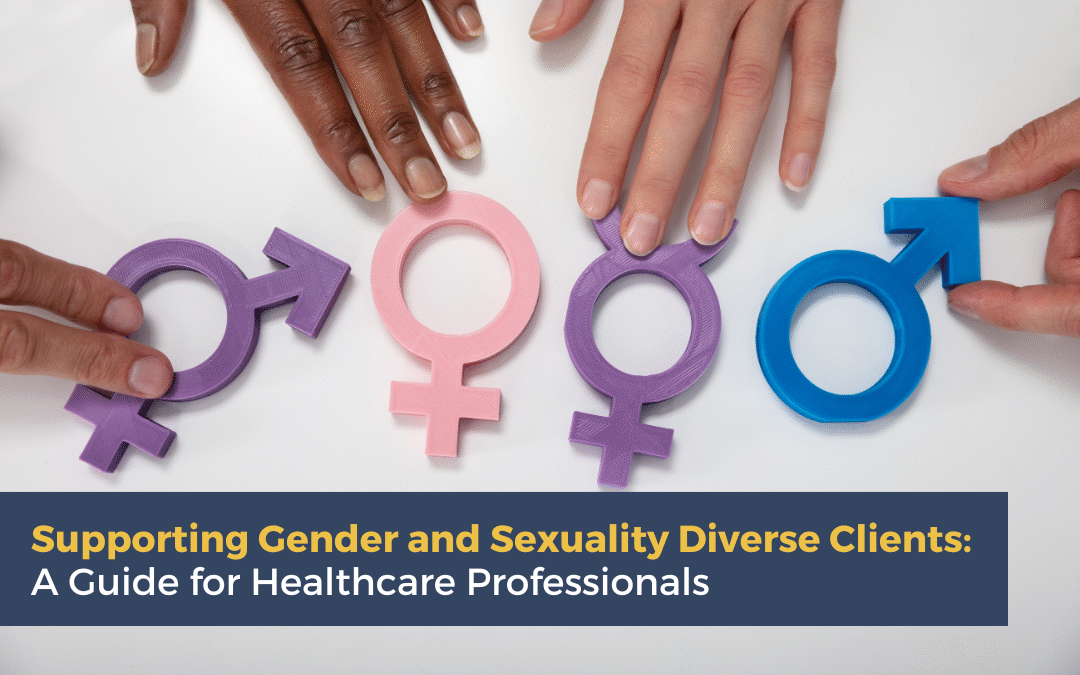As awareness of gender and sexuality diversity grows, healthcare professionals have a responsibility to create inclusive and affirming environments for all patients. For gender and sexuality diverse individuals, accessing healthcare can be a challenging experience due to systemic discrimination, misgendering, or a lack of understanding from providers. This guide offers practical ways to provide respectful, inclusive care to these communities.
Understanding Gender and Sexuality Diversity
Sex and gender are often confused, but they are distinct concepts. Sex is assigned at birth based on physical characteristics, while gender is an internal sense of identity. Many people align with the gender they were assigned at birth (cisgender), but others do not.
Gender identity is diverse and personal. It exists on a spectrum and can include:
- Transgender (Trans)* – A person whose gender identity is different from the sex assigned at birth.
- Nonbinary/Genderqueer – A gender identity that does not conform to the male/female binary. Some nonbinary people identify with multiple genders, while others do not identify with any.
- Gender-fluid – A person whose gender identity is flexible and may change over time.
- Intersex – A term for people born with physical, hormonal, or genetic characteristics that do not fit typical male or female definitions. While intersex refers to sex characteristics, not gender identity, intersex people may also identify as trans or nonbinary.
Why Inclusive Healthcare Matters
Gender and sexuality diverse individuals often face significant barriers when accessing healthcare. Negative experiences with medical professionals—including misgendering, assumptions about gender and sexuality, and a lack of knowledge—can discourage individuals from seeking care. Studies show that these barriers can contribute to poorer mental and physical health outcomes, including higher rates of depression, anxiety, and self-harm.
As a healthcare professional, you can help by fostering a supportive environment that validates and affirms patients’ identities.
Practical Steps for Inclusive Practice
1. Use Affirming Language
Language shapes experiences. Using inclusive terminology demonstrates respect and builds trust with gender and sexuality diverse patients.
- Pronouns matter. If you’re unsure of someone’s pronouns, use gender-neutral ones (they/them) until you can ask. For example: “Hi, I’m Dr Smith. My pronouns are she/herhow about you?”
- Avoid invalidating terms. Instead of “preferred pronouns” or “preferred name,” simply say “name” and “pronouns.” This affirms that these are not preferences but integral parts of a person’s identity.
- Respect chosen names. If a patient has changed their name, avoid using their deadname (the name they were given at birth but no longer use).
2. Adapt Intake Forms & Records
Your practice’s paperwork and administrative processes should reflect inclusivity.
- Include a “Name in use” or “Chosen name” field. A young person’s intake form may be completed by a parent or carer who is unaware of their chosen name.
- Allow patients to indicate their pronouns on forms.
- Avoid forcing patients to select only “Male” or “Female” when asking for genderconsider including an “Other” or “Prefer to self-describe” option.
3. Ensure Physical Spaces Are Welcoming
Your practice environment should reflect inclusivity.
- Have visible signs of LGBTQIA+ inclusivity, such as a small rainbow sticker or a poster affirming diverse identities.
- If directing patients to the toilet, include the all-access toilet and use the term “all-access” rather than “unisex” or “disabled toilet.”
- Ensure staff receive ongoing training in gender and sexuality diversity to prevent missteps and improve patient experiences.
4. Handle Mistakes Gracefully
Even well-intentioned professionals make mistakes. If you misgender a patient or use the wrong name, simply apologise, correct yourself, and move on. For example:
❌ “Oh my god, I’m so sorry! I didn’t mean to do that, I feel awful!”
✔ “Sorry, I meant to say ‘they’ thank you for letting me know.”
Over-apologising can make the situation uncomfortable and put the emotional burden on the patient to reassure you.
5. Respect Confidentiality
Many gender and sexuality diverse young people are not “out” to their families. If you need to contact a patient’s parent or carer, first check with the patient how they would like to be addressed. They may not feel safe using their chosen name or pronouns in front of family members.
6. Provide Affirming Healthcare
Be mindful that many healthcare systems are based on binary assumptions. When discussing medical care, be sensitive to the language you use. For example:
- A trans man may still require gynaecological care, but referring to it as “women’s health” may be alienating.
- A nonbinary person may not feel comfortable answering questions framed in strictly male or female terms.
Ask open-ended questions such as:
✅ “Do you have any specific concerns about your health today?”
✅ “Are there any aspects of your care that you’d like to discuss?”
How to Respond When a Patient Opens Up
If a patient discusses their gender or sexuality, listen with openness, curiosity, and care. Avoid making assumptions, and let them lead the conversation.
- Instead of: “Are you sure this isn’t just a phase?”
Say: “Thank you for sharing that with me. How can I support you?” - Instead of: “I don’t understand all these new terms.”
Say: “I’m always learning,let me know if I get something wrong.”
A supportive response can make a significant difference in whether a patient feels comfortable seeking help again.
Further Support & Resources
For additional guidance and patient referrals, these Australian organisations provide excellent resources:
- Minus18 – LGBTQIA+ youth support, education, and resources.
- Rainbow Door – Free helpline offering support and referrals for LGBTIQA+ individuals and their families.
- QLife – Peer-based support for LGBTIQA+ individuals, their loved ones, and professionals.
The Impact of Inclusive Care
By integrating these simple but meaningful practices, healthcare professionals can create a safe, respectful environment for gender and sexuality diverse patients. An affirming interaction with a GP or therapist can have a lasting impact, helping to build trust and ensure patients feel seen, heard, and supported in their healthcare journey.
Looking to Learn More?
At The Therapy Hub, we support professionals in building inclusive and affirming practices. If you’re interested in training or resources, get in touch with our team.








Recent Comments